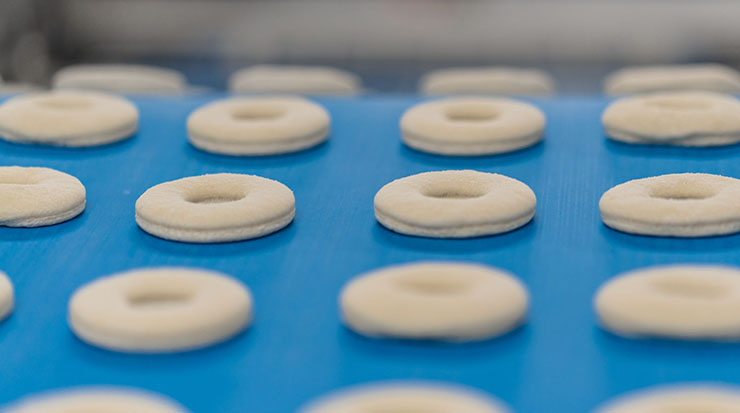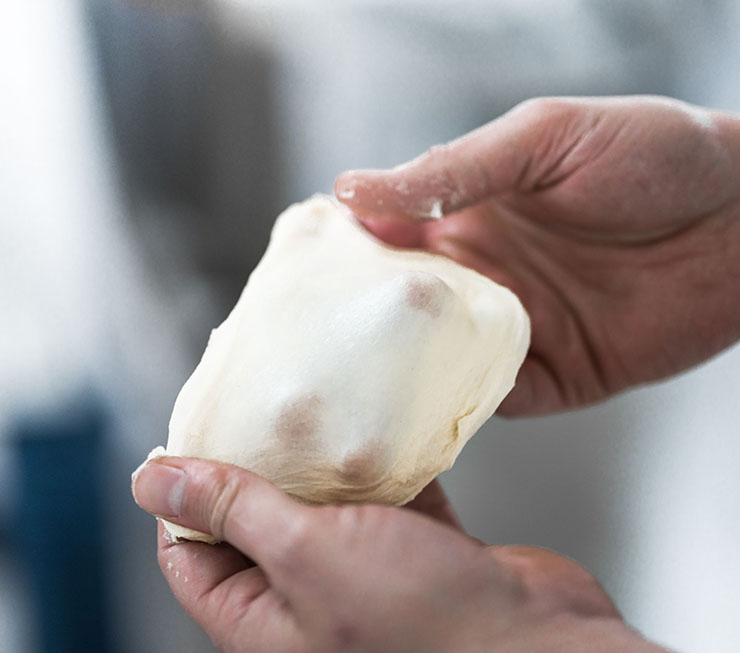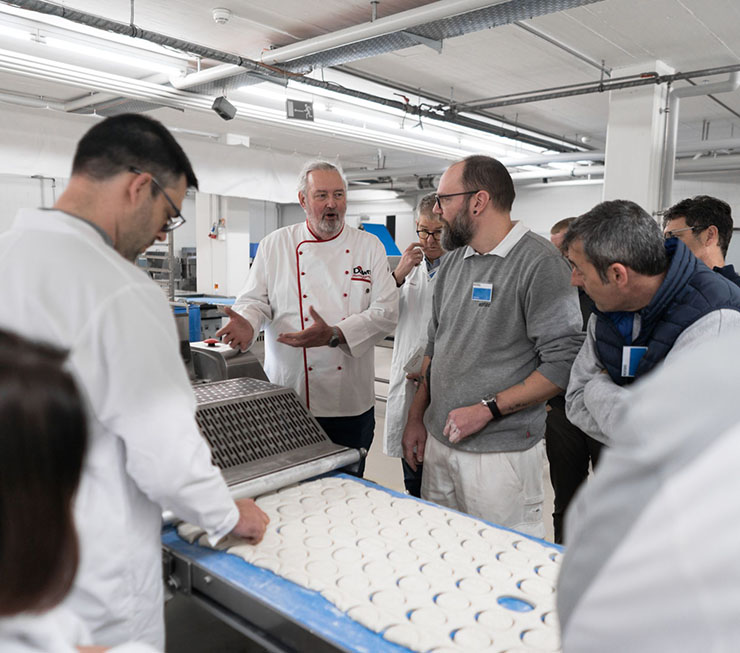
Each process stage, from mixing to creating the dough band and donut shapes, through to baking, contributes to their final quality. It also holds opportunities to optimize production, such as correctly introducing re-work dough into production, for semi-automated and fully-automated operations.
Earlier this year, Dawn Foods’ Europe & AMEAP team held a seminar together with RONDO, where specialists from both companies pooled together their expertise in everything donuts. It was held at RONDO’s Dough-How Center in Burgdorf. RONDO and the ingredient specialist worked on being able to speak the same language when visiting common customers and working on improving their donut manufacturing process, Alexander Weissbach, Head of Technology and Product Management at RONDO Burgdorf AG, pointed out.
Semi-industrial and industrial donuts, all donuts
Depending on the automation level of the operation, RONDO can provide training about the recipe, the process, and the critical control points in manufacturing. Some of these points that startup bakeries should master can be handling the dough and the dough band tension, managing the size and the weight of the product, how the dough should progress along the line, what temperature parameters should be maintained throughout the process, and using re-work dough. It acts like sourdough; as it starts to ferment and swell, it builds up taste, and the water is better bound to the flour. “There are no downsides to using re-work dough; on the contrary, it is beneficial to include it as it makes the donuts denser, tastier and it helps to keep the donut fresher for longer,” RONDO’s specialist points out.
For semi-industrial operations that want to upgrade and/or expand, the focus of guideline recommendations will be on achieving a constant production flow. A process based on manual operations can afford to have resting last for some minutes longer than optimum when making smaller product batches; however, on a semi-automated or fully-automated line, the dough rheology should be always consistent, or it will impact the final shape of the products, Weissbach explains. “At this stage, all the process guidelines should be followed strictly. All critical control points must be in check,” he recommends.
Going out of optimum parameters here will influence the dough sheeting process and, ultimately, the roundness of the product. RONDO offers an example in this regard: a bakery cutting the dough manually for their donuts upgraded to a Cutomat automated machine from RONDO. At first, they were not able to perform the cuts to obtain the donut shapes out of the dough band: the dough would not be cut all the way through, or there was too much tension on the dough. The sheeter was the prime suspect initially, but the issue came from incorrect dough development. The dough had not been mixed long enough, making it hard to sheet and then cut.

Another scenario where process and ingredient knowledge help optimize donut production is when reintroducing re-work dough into production. The recipe needs to be slightly adapted from time to time. It may cause the dough temperature to rise when it is introduced into the mixing bowl, so the balance needs to be restored to bring the dough on the line at the correct temperature. On semi-automatic systems (batch production using equipment such as automated sheeters and cutting tables), the scrap dough mesh is automatically removed from the line, then collected in boxes to be brought back to the mixer by an operator. Four or five people need to run this type of line, for tasks including dough scaling, sheeting, cutting and panning. Each of these processes can be gradually automated on the semi-automated line.
For semi-automated lines (continuous sheeting lines), several process steps are automated. Depending on the level of automation, the number of operators can be reduced to 1-2, while increasing output two- or three-fold, compared with a semi-automatic system. The Smart Donut line is an example of such a line.
For continuous production on fully-automated lines, cross conveyor belts can bring the re-work dough back to mixing. The correct amount of re-work dough will be added into the mixer, also automatically (around 50% of the full volume being prepared), no manual scaling is required. An automated line requires only one operator and achieves even higher outputs.
When having a new line installed, operators receive specialty training from RONDO’s master bakers. They are instructed on how to check if the setup is done correctly and what the dough band looks like when it isn’t (the dough surface is no longer smooth). They also learn what adjustments they need to make in such cases.

From dough band to donut
Once the dough band is formed in the desired width and thickness, product variations will only involve swapping the stamping die, for unlimited shape options, from the classic ring and circular shapes to more unusual patterns (stars, apples, pumpkins, etc.). This changeover is done in a matter of seconds, RONDO explains. In addition to variety in shapes, RONDO equipment is also flexible around different recipes. Dough bands made of sweet yeast dough, gluten-free dough, free-from products such as egg-free dough, or free-from additives can run on the sheeting line with the same setup. ‘Donut-adjacent’ products can also be made in the same way – coffee rolls or cinnamon buns, for instance. In this case, the dough band is made slightly thinner than required for donuts, and then sprinkled with cinnamon and rolled into shape.
Alexander Weissbach,
Head of Technology and Product Management, RONDO
Some types of dough pose more challenges than others. Free-from doughs, for example, are more fragile and stickier. The laminating and sheeting line can be easily adjusted to overcome challenges; flour can be dispersed on the dough band, the specialist illustrates.
Some of the biggest donut producers in Europe work
together use RONDO sheeting and laminating fully-automated equipment. Well-adjusted processes and recipes are run continuously, without encountering problems over the years.


